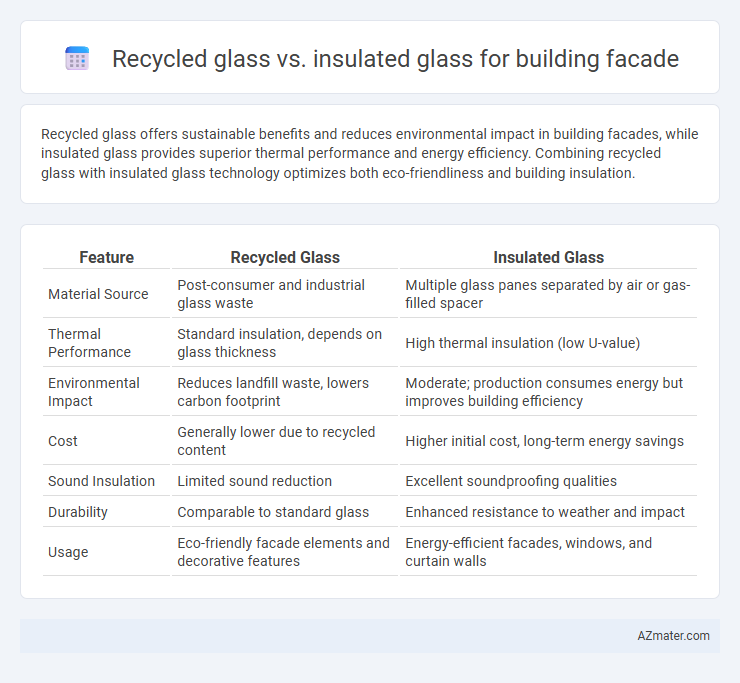Recycled glass offers sustainable benefits and reduces environmental impact in building facades, while insulated glass provides superior thermal performance and energy efficiency. Combining recycled glass with insulated glass technology optimizes both eco-friendliness and building insulation.
Table of Comparison
| Feature | Recycled Glass | Insulated Glass |
|---|---|---|
| Material Source | Post-consumer and industrial glass waste | Multiple glass panes separated by air or gas-filled spacer |
| Thermal Performance | Standard insulation, depends on glass thickness | High thermal insulation (low U-value) |
| Environmental Impact | Reduces landfill waste, lowers carbon footprint | Moderate; production consumes energy but improves building efficiency |
| Cost | Generally lower due to recycled content | Higher initial cost, long-term energy savings |
| Sound Insulation | Limited sound reduction | Excellent soundproofing qualities |
| Durability | Comparable to standard glass | Enhanced resistance to weather and impact |
| Usage | Eco-friendly facade elements and decorative features | Energy-efficient facades, windows, and curtain walls |
Introduction to Glass Facades in Modern Architecture
Recycled glass and insulated glass both play crucial roles in modern building facades, enhancing sustainability and energy efficiency. Recycled glass reduces environmental impact by reusing materials without compromising structural integrity, while insulated glass improves thermal performance through multiple glazing layers and gas fills. The integration of these materials supports green building standards, optimizing facade performance in contemporary architectural design.
What Is Recycled Glass?
Recycled glass is made from post-consumer and post-industrial glass waste that is crushed, cleaned, and reformed into new glass products, significantly reducing raw material consumption and energy use in manufacturing. In building facades, recycled glass offers environmental benefits by lowering carbon footprints and promoting sustainable construction practices without compromising aesthetic quality. Unlike traditional insulated glass units that focus on thermal performance through multiple panes and gas fills, recycled glass emphasizes resource efficiency and eco-friendliness in material sourcing.
Understanding Insulated Glass Units (IGUs)
Insulated Glass Units (IGUs) consist of two or more glass panes separated by an air or gas-filled space to enhance thermal performance and reduce energy loss in building facades. Recycled glass can be incorporated into IGUs, contributing to sustainability while maintaining similar insulating properties, but it requires careful processing to ensure clarity and durability. The combination of IGUs with recycled glass supports energy-efficient building designs by improving insulation and lowering the environmental impact of glass production.
Environmental Impact: Recycled vs Insulated Glass
Recycled glass for building facades significantly reduces raw material extraction and energy consumption by reusing post-consumer glass, leading to a lower carbon footprint compared to traditional insulated glass. Insulated glass units (IGUs) provide excellent thermal performance by minimizing heat transfer, which lowers building energy use for heating and cooling over time, indirectly reducing environmental impact. Combining recycled glass with insulated glass technology can optimize sustainability by leveraging material reuse and enhanced energy efficiency in facade applications.
Thermal Efficiency Comparison
Recycled glass in building facades offers moderate thermal insulation by incorporating cullet that improves material sustainability but typically lacks the advanced air or gas layers found in insulated glass. Insulated glass units (IGUs), consisting of multiple glass panes separated by gas-filled spaces, provide superior thermal performance by significantly reducing heat transfer and enhancing energy efficiency. Studies indicate that IGUs can achieve U-values as low as 0.2 W/m2K, outperforming single-pane recycled glass systems which often exceed 2.0 W/m2K in thermal transmittance.
Acoustic Performance in Building Facades
Recycled glass panels offer moderate acoustic insulation by reducing sound transmission through their dense, solid structure, making them a sustainable choice for building facades. Insulated glass units (IGUs), consisting of two or more glass panes separated by an air or gas-filled gap, provide superior acoustic performance by effectively dampening sound waves and minimizing noise infiltration. Combining recycled glass with insulated glass technology can enhance facade noise control while promoting environmental sustainability in construction.
Aesthetic Flexibility and Design Options
Recycled glass offers unique color variations and textures that enhance building facade aesthetics, allowing designers to create vibrant, sustainable visual effects. Insulated glass provides clear, sleek panels with customizable tinting and coatings, maximizing modern design flexibility while improving energy efficiency. Combining these materials allows architects to balance artistic expression and performance in facade applications.
Cost Analysis: Recycled Glass vs Insulated Glass
Recycled glass panels typically offer a more cost-effective solution for building facades, with raw material expenses reduced by up to 40% compared to insulated glass units (IGUs). Insulated glass entails higher upfront costs due to multiple glass layers and gas-filled cavities designed for thermal efficiency, often doubling the initial investment relative to recycled glass alternatives. Long-term energy savings from insulated glass can offset its premium price, but initial budget constraints make recycled glass a preferred option for cost-sensitive projects.
Durability and Maintenance Considerations
Recycled glass in building facades offers moderate durability with resistance to environmental wear but may require more frequent inspections due to potential porosity and surface imperfections. Insulated glass units (IGUs) provide superior durability, enhanced thermal performance, and sealed air gaps that reduce condensation and maintenance needs over time. Choosing insulated glass typically results in lower long-term maintenance costs and improved building envelope resilience compared to recycled glass options.
Choosing the Right Glass for Sustainable Facades
Recycled glass offers significant environmental benefits by reducing raw material extraction and energy consumption compared to traditional glass production, making it a sustainable option for building facades focused on eco-friendly design. Insulated glass units (IGUs) enhance thermal performance and energy efficiency by incorporating multiple glass panes separated by a spacer and sealed to reduce heat transfer, crucial for minimizing HVAC energy use in sustainable buildings. Selecting between recycled glass and insulated glass depends on balancing sustainability goals with performance requirements, where combining recycled materials with insulated glass technology can optimize both environmental impact and building envelope efficiency.

Infographic: Recycled glass vs Insulated glass for Building façade
 azmater.com
azmater.com